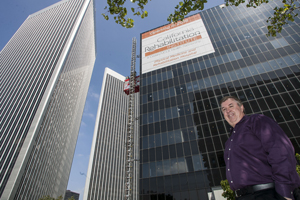
Fictional characters have been practicing medicine at Century City Hospital for years. That’s about to change, as the building prepares for teams of real practitioners to step in as part of the building’s conversion to a rehabilitation hospital.
Realtech Construction Co., the building’s operator, had offered up the facility to a steady stream of film and TV productions as it struggled to find a real hospital tenant after the departure of Tenet Healthcare Corp. in 2004.
Realtech’s consultants, said Jeff Buttikofer, the company’s chief operating officer and chief financial officer, talked to every hospital in the country.
Nobody bit.
“They found they’d have to be full in order to break a profit,” said Buttikofer, sitting in his firm’s penthouse perch in the neighboring medical office building. “The answer we got from most hospitals was we love the area, love the building, but there’s no money to be made in acute care hospitals unless they have some specialty.”
In the end, a specialty is exactly where Realtech found success.
The building caught the eye of Select Medical Holdings Corp., a Mechanicsburg, Pa., operator of rehabilitation hospitals and clinics nationwide. Select’s chief executive, David Chernow, got creative and cobbled together a partnership with Cedars-Sinai and UCLA to launch a 138-bed inpatient rehabilitation hospital that’s set to open early next year.
Acute care hospitals, with emergency rooms and surgery centers, are expensive to operate. But rehabilitation hospitals, which don’t have traditional emergency rooms and cater to recovering patients, are much less expensive to run. And there is a market need in Los Angeles for rehabilitation beds.
Cedars and UCLA together have roughly 40 inpatient rehab beds, which are usually full. With the opening of California Rehabilitation Institute, as the facility will be known, they will have a place to shift those patients. Select will manage the new venture, and the three partners will share the profits.
The partnership between heavyweight competitors Cedars and UCLA made sense to Steven Valentine, president of El Segundo health care consulting firm Camden Group.
“As soon as I saw it I thought, ‘Oh, my gosh, two competitors collaborating,’” Valentine said. “The more I thought about it, they probably needed both of these large institutions to generate enough rehab patients. … And they technically aren’t competing for rehab.”
He added that Los Angeles County doesn’t have many rehab beds and space is always at a premium at UCLA and Cedars, both of which could benefit from using more of their beds for higher revenue-generating adult acute care patients.
By locating the new rehab hospital in an empty building that needed a tenant, everybody comes out ahead.
“The UCLA-Cedars strategy is a really a good one,” Valentine said. “It’s a smart play.”
New lease
Realtech manages the dark glass hospital at 2070 Century Park East as well as the medical office building next door. They comprise the Century City Medical Plaza. Realtech’s president, David Wilstein, also is a principal in the real estate partnership that owns the plaza.
While the 211,000-square-foot, 19-floor medical office tower is nearly 95 percent leased, according to real estate data provider CoStar Group Inc., the 175,000-square-foot shorter hospital building next door is vacant but crawling with construction workers. They’re installing air conditioning and sprinklers along corridors that snake past patient rooms, physical therapy chambers and dining rooms with views of the gleaming Century Plaza Towers and Beverly Hills High School’s terra cotta rooftops.
“We’re sitting on a gold mine,” Realtech’s Buttikofer said. “It’s a prime piece of real estate.”
He said the firm could’ve made a killing by converting the hospital to office space, but Wilstein wanted to keep it a medical center.
The rehab institute will treat patients recovering from an array of ailments, from brain and stroke injuries to orthopedic cases. The group expects to draw complex cases from the region and across the nation.
Cedars Chief Executive Tom Priselac echoed others’ analysis of why the unusual deal worked for his organization.
“This joint venture enhances our ability to offer both high-quality services and address people’s concerns about the cost of health care,” he said. “To the extent people can be transferred to the rehab hospital, it would be less costly than having to be treated in an acute care setting.”
